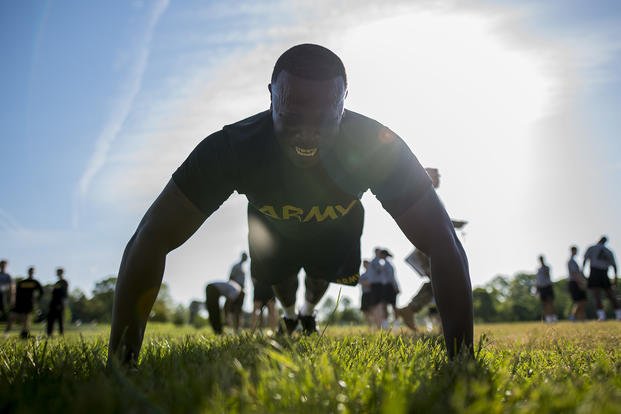If you're an infantry platoon sergeant, it doesn't matter if you're 25 or 55; all will be held to the same fitness standards with the future Army Combat Fitness Test.
The new test does away with age-specific standards and sets requirements based on job demands instead, Army officials said.
The current Army Physical Fitness Test is based on a scoring scale that does not require older soldiers to perform as well as their younger counterparts.
The new ACFT, which is scheduled to replace the APFT in October 2020, will consist of a scoring scale that's based on standards soldiers need to meet to survive in combat, according to Maj. Gen. Malcolm Frost, who is overseeing the ACFT as commanding general of the U.S. Army Center of Initial Military Training.
"The bottom line is combat does not discriminate, bullets coming at you don't discriminate, the enemy coming at you does not discriminate ... by height, by gender, by age, and, quite frankly, by what uniform you are wearing," Frost said.
"If you are a battalion O-5 or a brigade O-6 commander or command sergeant major that has been selected for the privilege to command or serve in a nominative position in a battalion or brigade in the United States Army, you must lead soldiers in combat and as such you must pass the Army Combat Fitness Test for whatever standard is designated," he said.
Beginning this October, the Army will select 60 battalions across the active Army, National Guard and Reserve to participate in one-year field test of the new ACFT to establish how the test will be scored, make adjustments to events as needed and consider the policies required to implement the new test, Frost said.
The six-year effort is based on several studies that have looked at the 113 warrior tasks and battle drills -- common tasks every soldier needs to be able to perform to survive on the battlefield -- as well as soldier feedback from the past 15 years of combat in Iraq and Afghanistan, he said.
The Army also ran two pilots last year looking at alternate tests such as the Army Combat Readiness Test before program officials decided on the six physical events that make up the ACFT.
The test events are designed to replicate physical tasks that every soldier must be able to perform in combat, such as evacuating a casualty from a combat vehicle, said Sgt. Maj. Daniel Dailey, sergeant major of the Army.
"That person inside that vehicle doesn't care whether you are a woman, a man, 50, 60, 18 or 24 -- he or she needs to come out if it's on fire," he said.
"This is a standards-based physical fitness assessment. What is the standard that you must perform as a soldier on the battlefield?" Dailey said. "So it is neutral with regards to everything but what is the standard to fight and win."
Once the field test is complete, all soldiers will begin taking the new ACFT in October 2019 to start training up to the new standard, but the current APFT will remain the test of record until October 2020, Army officials say.
The new scoring standards for the ACFT may be based on a soldier's occupation, as with the Occupational Physical Assessment Test, an evaluation the Army launched last year that requires all new recruits to pass based on the physical demands of the job they select.
The standards might also be different for two soldiers performing different jobs in the same military occupational specialty (MOS), Frost said.
"An E7 who is serving on an Army command staff versus a sergeant first class who is a platoon sergeant in an infantry battalion -- they may be the same MOS but does that mean that the actual occupation of what they do is the same? ... All of this has to be looked at, and we have to understand them through the lens of the realities involved in the Army," he said.
-- Matthew Cox can be reached at matthew.cox@military.com.













